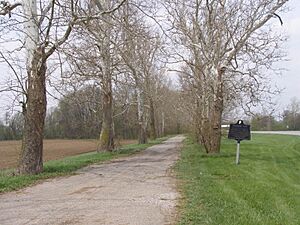Sycamore Row (road) facts for kids
Sycamore Row is a special part of a road in Carroll County, Indiana. It's famous because it's lined with many tall sycamore trees. These trees grew from sycamore logs that were placed there way back in the 1830s. This was done to build a special type of road called a corduroy road across very wet, swampy land.
This historic spot was once part of Indiana State Road 29. Today, the main State Road 29 goes around Sycamore Row, so regular cars don't drive on it anymore. The Indiana Historical Bureau has even placed a special marker there to remember its history.
Contents
How Sycamore Row Was Built
Back in the 1830s, people needed good roads to travel across Indiana. One important road was the Michigan Road. By 1837, this road had reached a town called Logansport.
Early Road Building Challenges
The first roads were often just dirt paths. They also had simple bridges made of logs. These roads would get muddy and bumpy every time it rained or snowed. It was hard to travel on them!
The Idea of Plank Roads
By 1850, the state decided to make the Michigan Road better by covering it with wood. This new type of road was called a plank road.
- First, the ground was made flat.
- Then, long logs called "sleepers" were laid down along the sides of the road.
- Next, thick wooden planks, about 2 or 3 inches (5.1 or 7.6 cm) thick, were nailed across these sleepers.
These wooden planks made the road smooth and free from mud and dust. However, over time, mud could still splash up between the planks, making some parts difficult to use.
Toll Roads and Sycamore Row
Building and keeping up these plank roads was expensive. So, many of them became toll roads. This meant drivers had to pay a small fee to use them. There was a toll booth right at the south end of Sycamore Row, in a place called Deer Creek.
Is the Sycamore Story True?
We know for sure that the Michigan Road went through what is now Sycamore Row. However, the exact story of how the sycamore trees came to line the road isn't fully proven. The historical marker at the site has been looked at closely since 2010 to make sure all the facts are correct.


